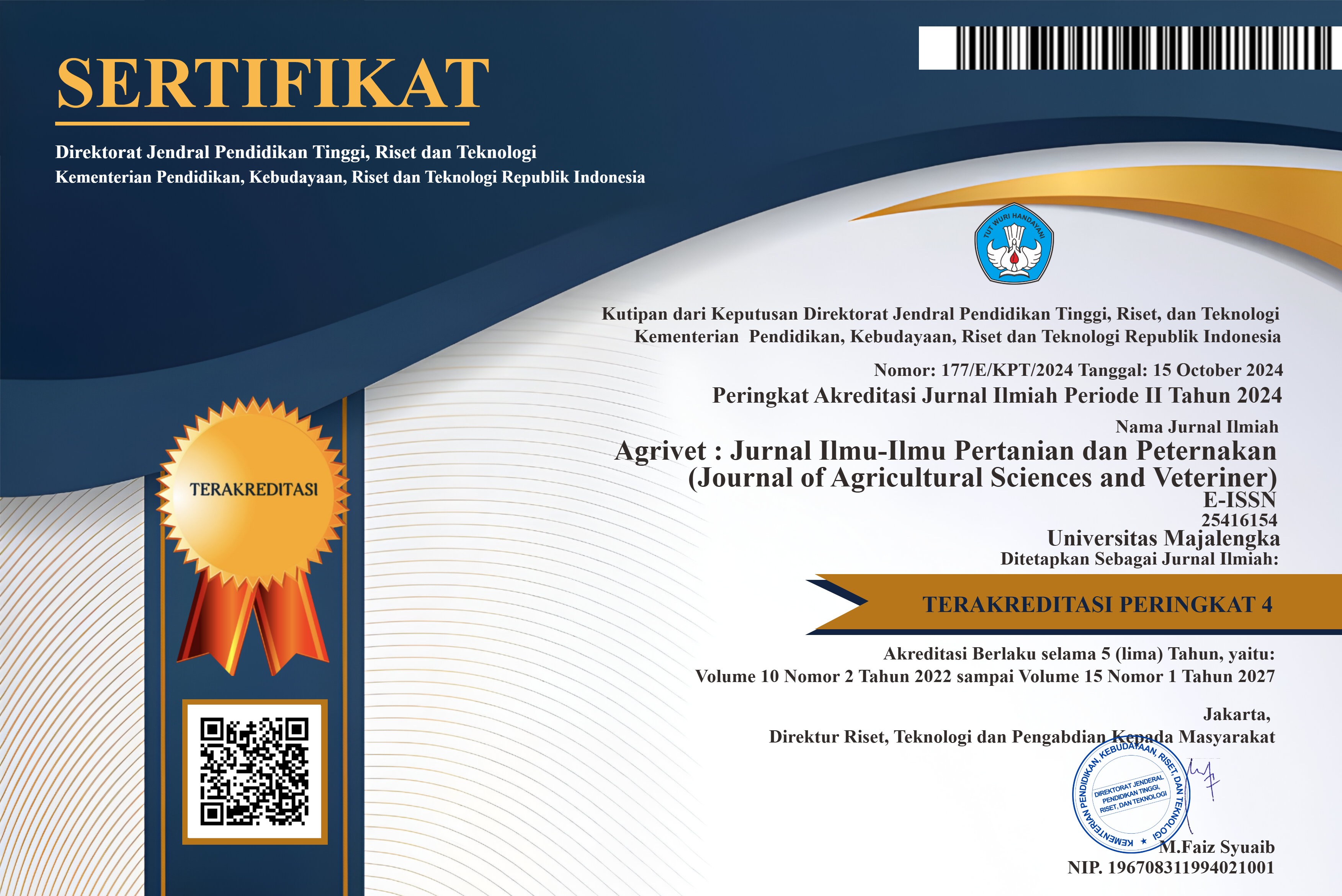TINGKAH LAKU KAWIN ENTOG CIAYUMAJAKUNING PADA SYSTEM PEMELIHARAAN INTENSIF
DOI:
https://doi.org/10.31949/agrivet.v9i2.1722Abstract
Muscovy duck development can be influenced by reproductive performance, including mating behavior. The purpose of the study was to obtain the quantitative characteristics of the Ciayumajakuning Muscovy duck mating and to obtain the best antog in its mating characteristics. The research method was carried out experimentally using a completely randomized design with 4 treatments and 5 replications. The parameters observed were mating frequency, mating duration, mating time, and mating location. The results showed that the quantitative characteristics of the antog Kuningan showed a significant difference in the frequency of mating with the drake and duck and the duration of mating was higher than that of the Cirebon, Indramayu, and Majalengka Muscovy duck. This is supported by data on the frequency of mating with 7.4 drake and duck 2 times/day, and the mating duration is 119.4 seconds. The mating time of the Cirebon, Indramayu, Majalengka, and Kuningan Muscovy duck did not show a significant difference, namely more in the first and second quarters at 06.01-12.00 WIB and 12.01-16.00 WIB. The mating location is in zone 1 in the area near the place of feed and drinking water. In conclusion, Muscovy duck Kuningan has the best marital characteristics.
Keywords:
mating behavior, Muscovy duck, CiayumajakuningDownloads
References
Abdel-Hamid, S. El, Saleem, A. S. Y., Youssef, M. I., Mohammed, H. H., & Abdelaty, A. I. (2020). Influence of housing systems on duck behavior and welfare. Journal of Advanced Veterinary and Animal Research. https://doi.org/10.5455/javar.2020.g435
Banga-Mboko, H., Lelou, B., Maes, D., & Leroy, P. L. (2007). Indigenous Muscovy Ducks in Congo Brazzaville. 2. Preliminary observations on indigenous Muscovy ducks reared under moderate inputs in Congolese conditions. Tropical Animal Health and Production. https://doi.org/10.1007/s11250-007-4235-0
Batellier, F., Marchal, F., Scheller, M. F., Gautron, J., Sellier, N., Taouis, M., Monbrun, C., Vignal, A., & Brillard, J. P. (2004). Sex ratios in mule duck embryos at various stages of incubation. Theriogenology. https://doi.org/10.1016/S0093-691X(03)00208-5
Bati, J., Biza-Koukaba, C., Banga-Mboko, H., Mfoukou-Ntsakala, A., Bakoutana, D., Adzona, P., Hornick, J., & Leroy, P. (2014). Phenotypic Characterization According to The Feather Color of Indigenous Muscovy Ducks Bred in The Back Yard in Brazzaville, The Congo. ANIMAL PRODUCTION. https://doi.org/10.20884/1.anprod.2014.16.3.459
Brun, J. M., Richard, M. M., Marie-Etancelin, C., Rouvier, R., & Larzul, C. (2005a). Le canard mulard: Déterminisme génétique d’un hybride intergénérique. Productions Animales. https://doi.org/10.20870/productions-animales.2005.18.5.3534
Brun, J. M., Richard, M. M., Marie-Etancelin, C., Rouvier, R., & Larzul, C. (2005b). The mule duck: Genetic determinism of an intergeneric hybrid. Productions Animales.
Brun, Jean Michel, Bernadet, M. D., Cornuez, A., Leroux, S., Bodin, L., Basso, B., Davail, S., Jaglin, M., Lessire, M., Martin, X., Sellier, N., Morisson, M., & Pitel, F. (2015). Influence of grand-mother diet on offspring performances through the male line in Muscovy duck. BMC Genetics. https://doi.org/10.1186/s12863-015-0303-z
Castillo, A., Schiavone, A., Cappai, M. G., Nery, J., Gariglio, M., Sartore, S., Franzoni, A., & Marzoni, M. (2020). Performance of slow-growing male muscovy ducks exposed to different dietary levels of quebracho tannin. Animals. https://doi.org/10.3390/ani10060979
Costa, V. R., Cruz, F. G. G., Rufino, J. P. F., Silva, A. F., Freitas, B. K. M., Feijó, J. C., & Guimarães, C. C. (2019). Available phosphorus levels in diets for muscovy ducks in housing. Revista Brasileira de Ciencia Avicola. https://doi.org/10.1590/1806-9061-2018-0914
Damaziak, K., Michalczuk, M., Adamek, D., Czapliński, M., Niemiec, J., Goryl, A., & Pietrzak, D. (2014). Influence of housing system on the growth and histological structure of duck muscles. South African Journal of Animal Sciences. https://doi.org/10.4314/sajas.v44i2.1
EI-Badry, A., Abdel-Fattah, S., & Moslim, G. (2015). EFFECT OF EARLY HEAT CONDITIONING AND LIGHTING REGIME ON PHYSIOLOGICAL AND IMMUNE RESPONSES OF MUSCOVY DUCKS DURING SUMMER SEASON. Journal of Animal and Poultry Production. https://doi.org/10.21608/jappmu.2016.52741
El. Abdel-Hamid, S., & Abdelfattah, E. M. (2020). Effect of different dietary protein levels on some behavioral patterns and productive performance of muscovy duck. Advances in Animal and Veterinary Sciences. https://doi.org/10.17582/JOURNAL.AAVS/2020/8.6.661.667
Etuk, I. F., Abasiekong, S. F., Ojewola, G. S., & Akomas, S. C. (2006). Carcass and organ characteristics of muscovy ducks reared under three management systems in South Eastern Nigeria. International Journal of Poultry Science. https://doi.org/10.3923/ijps.2006.534.537
Etuk, I. F., Ojewola, G. S., & Abasiekong, S. F. (2006). Performance of muscovy ducks under three management systems in South Eastern Nigeria. International Journal of Poultry Science. https://doi.org/10.3923/ijps.2006.474.476
Farghly, M. F.A., El-Hack, M. E. A., Alagawany, M., Saadeldin, I. M., & Swelum, A. A. (2018). Wet feed and cold water as heat stress modulators in growing Muscovy ducklings. Poultry Science. https://doi.org/10.3382/ps/pey006
Farghly, Mohamed F.A., & Mahmoud, U. T. (2018). Access to outdoor swimming pond during summer season improved Muscovy ducks performance and health status. Livestock Science. https://doi.org/10.1016/j.livsci.2018.03.008
Ismoyowati, Tugiyanti, E., Mufti, M., & Purwantini, D. (2017). Sexual dimorphism and identification of single nucleotide polymorphism of growth hormone gene in muscovy duck. Journal of the Indonesian Tropical Animal Agriculture. https://doi.org/10.14710/jitaa.42.3.167-174
Kokoszyński, D., Wilkanowska, A., Arpášová, H., & Hrnčár, C. (2020). Comparison of some meat quality and liver characteristics in Muscovy and mule ducks. Archives Animal Breeding. https://doi.org/10.5194/aab-63-137-2020
Lin, C. W., Wei, L. Y., Chang, Y. Y., Liu, H. C., Lee, H. H., Yu, Y. H., & Chen, M. C. (2020). Effects of polymorphisms in the endothelin receptor B subtype 2 gene on plumage colour in mule ducks. South African Journal of Animal Sciences. https://doi.org/10.4314/SAJAS.V50I2.14
Mohammed, A. A. A., Abdel-rahman, M. A. M., & Darwish, M. H. A. (2015). Influence of Swimming Deprivation on Behavior , Performance and some Blood Parameters of Muscovy Ducks. Journal of Advanced Veterinary Research.
Oguntunji, A. O., & Ayorinde, K. L. (2015). Phenotypic characterization of the Nigerian Muscovy Ducks (Cairina moschata). Animal Genetic Resources/Ressources Génétiques Animales/Recursos Genéticos Animales. https://doi.org/10.1017/s2078633614000472
Rashid, M., Kawsar, M., Rashid, M., Miah, M., & Howlider, M. (2013). Fertility and Hatchability of Pekin and Muscovy Duck Eggs and Performance of Their Ducklings. Progressive Agriculture. https://doi.org/10.3329/pa.v20i1-2.16859
Rochlitz, I., & Broom, D. M. (2017). The welfare of ducks during foie gras production. Animal Welfare. https://doi.org/10.7120/09627286.26.2.135
Rufino, J. P. F., Cruz, F. G. G., Melo, R. D., Feijó, J. C., Damasceno, J. L., & Costa, A. P. G. (2017). Performance, carcass traits and economic availability of muscovy ducks fed on different nutritional plans in different housing densities. Revista Brasileira de Ciencia Avicola. https://doi.org/10.1590/1806-9061-2017-0471
Sellier, N., Brun, J. M., Richard, M. M., Batellier, F., Dupuy, V., & Brillard, J. P. (2005). Comparison of fertility and embryo mortality following artificial insemination of common duck females (Anas Platyrhynchos) with semen from common or Muscovy (Cairina Moschata) drakes. Theriogenology. https://doi.org/10.1016/j.theriogenology.2004.12.010
Stai, S. M., & Searcy, W. A. (2010). Passive sperm loss and patterns of sperm precedence in Muscovy Ducks (Cairina moschata). Auk. https://doi.org/10.1525/auk.2010.09138
Tamsil, H. (2018). Genetic Resource of Muscovy Duck (Cairina moschata): Profile and Potential Production as Meat Producer. Indonesian Bulletin of Animal and Veterinary Sciences. https://doi.org/10.14334/wartazoa.v28i3.1839
Tanganyika, J., & Webb, E. C. (2019). Influence of production systems and sex on nutritional value and meat quality of native Malawian Muscovy ducks. South African Journal of Animal Sciences. https://doi.org/10.4314/SAJAS.V49I6.15
Widianingrum, D., Widjastuti, T., Anang, A., & Setiawan, I. (2020). Technical characteristics of Muscovy duck (Cairina Moschata) in Ciayumajakuning, West Java Indonesia. Journal of Agricultural Sciences - Sri Lanka. https://doi.org/10.4038/jas.v15i2.8814
Yakubu, & Ugbo, S. B. (2011). An assessment of biodiversity in morphological traits of Muscovy ducks in Nigeria using discriminant analysis. BIOLOGY, ENVIRONMENT AND CHEMISTRY.
Ye, P., Li, M., Liao, W., Ge, K., Jin, S., Zhang, C., Chen, X., & Geng, Z. (2019). Hypothalamic transcriptome analysis reveals the neuroendocrine mechanisms in controlling broodiness of Muscovy duck (Cairina moschata). PLoS ONE. https://doi.org/10.1371/journal.pone.0207050
Published
How to Cite
Issue
Section
License
An author who publishes in the Jurnal Agrivet agrees to the following terms:
- Author retains the copyright and grants the journal the right of first publication of the work simultaneously licensed under the Creative Commons Attribution-ShareAlike 4.0 License that allows others to share the work with an acknowledgment of the work's authorship and initial publication in this journal
- The author is able to enter into separate, additional contractual arrangements for the non-exclusive distribution of the journal's published version of the work (e.g., post it to an institutional repository or publish it in a book) with the acknowledgment of its initial publication in this journal.
- The author is permitted and encouraged to post his/her work online (e.g., in institutional repositories or on their website) prior to and during the submission process, as it can lead to productive exchanges, as well as earlier and greater citation of the published work









